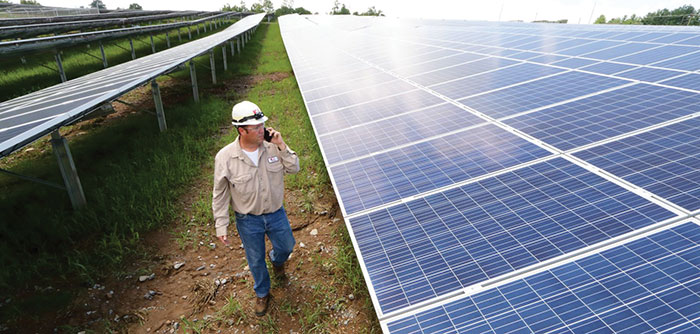By Robert Hadley

Central Kentuckians have always enjoyed lower than the national average in utilities costs for both residential and commercial rates, and Kentucky was at the forefront of the rhetorical battle over saving coal jobs during the last presidential election. Since then, however, the state has emerged as a player in the solar and renewable energy game.
 Last November, Kentucky’s Touchstone Energy Cooperatives, serving more than one million Kentucky residents in 87 counties, completed its 60-acre solar farm in Clark County. Operated by East Kentucky Power Cooperative, the solar farm offered consumers a ground-floor opportunity to license one of its more than 30,000 solar panels for just $460 per panel. Good for 25 years, the licenses entitled their buyers to an energy rebate equivalent to how much energy the panel delivered back to the grid.
Last November, Kentucky’s Touchstone Energy Cooperatives, serving more than one million Kentucky residents in 87 counties, completed its 60-acre solar farm in Clark County. Operated by East Kentucky Power Cooperative, the solar farm offered consumers a ground-floor opportunity to license one of its more than 30,000 solar panels for just $460 per panel. Good for 25 years, the licenses entitled their buyers to an energy rebate equivalent to how much energy the panel delivered back to the grid.
“Response to the Cooperative Solar program has been tremendous,” said Nick Comer, external affairs manager for EKPC. “Cooperative members have the option to participate in renewable energy and many are taking advantage of that opportunity. “
Nationwide, solar energy has seen growing implementation. Additionally there has been an overall 60 percent reduction in the costs of solar panels and other associated hardware just since 2010, as the Energy Department reports.
An indication of solar power’s rising viability is that one of the hottest issues in the 2018 Kentucky General Assembly session turned out to be reimbursement rates for the excess power private panels feed back into the grid. The term for such reimbursement plans is net metering. There is still debate on best practices, but the consensus remains that new utilities options need to be explored, and Central Kentucky businesses are taking up the charge.
The Kentucky Conservation Committee cites statistics that show solar energy jobs were up 20 percent in Kentucky between 2015 and 2016.
Kentucky Utilities
With solar energy offering the potential to lessen coal dependence and create jobs, it’s no wonder that Kentucky Utilities also offers a solar program.
The J.D. Power Customer Service award-winning energy provider operates the E.W. Brown Generating Station in Harrodsburg. The site is capable of generating “749 megawatts of electricity, more than one-fifth of KU’s total capacity,” according to its website.
In 2016, a 50-acre solar farm featuring 44,000 panels capable of producing 10 megawatts came online at the Harrodsburg facility. Projections are that this will send energy to up to 1,500 residential customers when its full power production of 19,000 megawatts is reached.
LG&E and KU trace a long involvement in sustainable energy, including two Ohio River hydroelectric facilities since the 1920s, Pratt said.
In an effort to expand their renewable energy offerings, LG&E and KU recently launched an initiative to allow businesses to invest in solar panels to defray energy costs.
Wealth of options
Central Kentucky utility customers benefit from innovation and low cost that, combined with the variety of services offered, is hard to find anywhere else. Ample, low-priced water is one of them.
Kentucky American Water, a subsidiary of investor-owned American Water, provides water to almost 130,000 customers in 11 counties including Fayette. The company recently completed $1.5 million in water main replacements in downtown Lexington. Projects like this are part of the company’s ongoing water system improvement efforts to ensure quality, reliable water service for its customers and total about $20 million annually.
In June 2018, Kentucky American Water received national recognition for its demonstrated commitment to exceptional water treatment operations. The company’s Kentucky River Station I and Richmond Road Station water treatment facilities in Lexington received prestigious 20-Year Directors Award recognition from the Partnership for Safe Water, an alliance of the American Water Works Association (AWWA), the U.S. Environmental Protection Agency (EPA), the Association of Metropolitan Water Agencies, the Association of State Drinking Water Administrators, the National Association of Water Companies and the Water Research Foundation.
These two facilities are among just 14 treatment plants across the country to achieve this 20-year distinction




















Add Comment